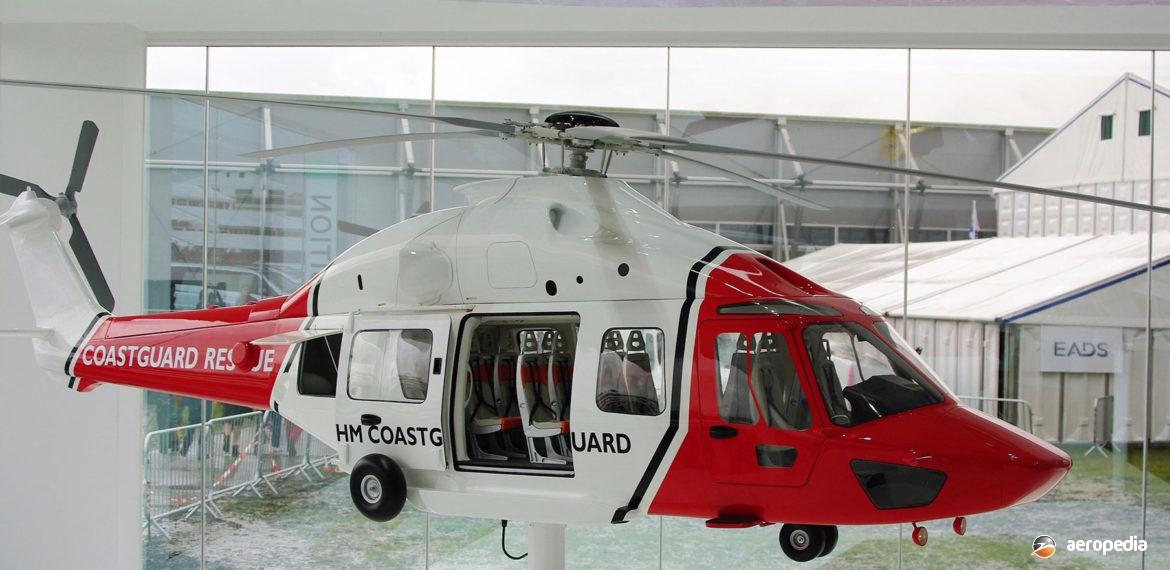Photograph:
Eurocopter EC-175 Coastguard model at Farnborough in July 2012 (David C Eyre)
Country of origin:
France / China
Description:
Multi-mission helicopter
Power Plant:
Two 1,324 kw (1,775 shp) Pratt & Whitney P76C-67E turboshafts
Specifications:
- Length overall, rotors turning: 18.06 m (59 ft 2 in)
- Rotor diameter: 14.8 m (48 ft 5 in)
- Height: 4.85 m (17 ft 5 in)
- Max speed: 324 km/h (201 mph)
- Cruising speed: 274 km/h (170 mph)
- Rate of climb at sea level: 474 m/min (1,555 ft/min)
- Service ceiling: 4,572 m (15,000 ft)
- Hovering ceiling in ground effect: 3,209 m (10,528 ft)
- Hovering ceiling out of ground effect: 1,656 m (5,432 ft)
- Cabin volume: 81.9 m³ (2,892 cub ft)
- Fuel capacity: 2,615 litres (575 Imp gals)
- Range with standard fuel: 1,091 km (678 miles)
- Empty weight: 4,650 kg (10,251 lb)
- Useful load: 3,152 kg (6,949 lb)
- Loaded weight: 7,800 kg (17,196 lb)
History:
The Eurocopter EC-175 was a multi-mission helicopter intended for the civil market which was developed by Eurocopter with the Harbin Aviation Industry Group in a joint venture. The program was launched on 5 December 2005 during a visit of the Prime Minister of China, Wen Jiabao, to France, the announcement stating the first flight would be made in 2009, the helicopter would receive certification in both countries, and it would enter series production in 2011. It was aimed at the offshore oil and gas mission roles, as well as search-and-rescue, homeland security, emergency medical services (EMS), and air transport operations.
The program was launched at Heli-Expo 2008 in Houston, Texas, a full-scale mock-up forming part of the Company’s display. At that event the Company took orders for 111 examples, two of the orders being placed by the Bristow Group and the VIH Aviation Group in Canada. Further orders were soon placed, including from the United Kingdom-based Bond group. Initial orders were mainly for machines to be used in either search-and-rescue work or for off-shore oil and gas missions.
The program was a joint 50/50 venture between the two countries, France and China, assembly lines being set up in both countries, investigations revealing a potential market for up to 800 helicopters in this category over a 20 year period. The EC-175 was aimed at the gap between the 5-tonne Aerospatiale Dauphin and the 10-tonne Aerospatiale Super Puma. It features the latest avionics and cockpit equipment, having four LCD displays, cabin and cockpit air conditioning, emergency flotation devices, a five-blade Spheriflex main rotor, a four-axis digital automatic flight control system and a high-energy crash absorbing airframe.
Power was provided by two Pratt & Whitney PT6C-67E turboshafts with FADEC. It was operated by a crew of one or two pilots, and was able to carry up to 16 passengers at 280 km/h (174 mph) for 370 km (230 miles). The machine had Sea State 6 capability with a high helicopter waterline.
At the Heli-Expo 2008 held in Houston Texas, Helicopters New Zealand announced it had placed a letter of intent for an early production example of the EC-175. In due course Eurocopter became known as Airbus Helicopters and the design became known as the H175. For long-range missions the H175 could transport 12 passengers for a radius of 408 km (253 miles) and if it was fitted with an 18-seat configuration it had a radius of action of 241 km (150 miles).
The cabin was said to be the largest in its class with a 12 m³ (424 cub ft) capacity and had Type IV emergency exits, energy attenuating seats, and large-capacity front and aft emergency flotation devices. The aircraft had an under floor fuel system and fuel capacity was 2,616 litres (575 Imp gals). The main gearbox was capable of 30 minutes of flight after total loss of oil and was fitted with two accessory gearboxes for redundancy. A de-clutch capability provided the benefits of an auxiliary power unit without the cost and weight penalties of an APU.

